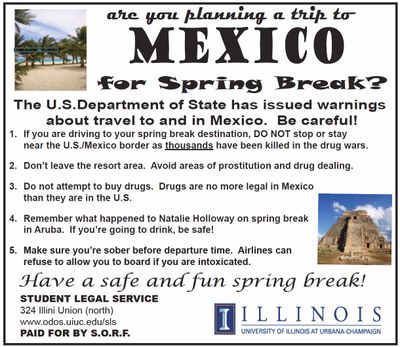Spring break alert issued for Mexico

PHOENIX – The U.S. State Department and universities around the country are warning college students headed for Mexico for some spring-break partying of a surge in drug-related murder and mayhem south of the border.
“We’re not necessarily telling students not to go, but we’re going to certainly alert them,” said Tom Dougan, vice president for student affairs at the University of Rhode Island. “There have been Americans kidnapped, and if you go you need to be very aware and very alert to this fact.”
More than 100,000 high school- and college-age Americans travel to Mexican resort areas during spring break each year. Much of the drug violence is happening in border towns, and tourists have generally not been targeted, though there have been killings in the big spring-break resorts of Acapulco and Cancun, well away from the border.
The University of Arizona in Tucson is urging its approximately 37,000 students not to go to Mexico. Other universities – including Penn State, Notre Dame, the University of Colorado and the University at Buffalo – said they would call students’ attention to the travel warning issued last Friday by the State Department.
The State Department stopped short of warning spring breakers not to go to Mexico, but advised them to avoid areas of prostitution and drug-dealing and take other precautions.
“Sage advice,” said Tom Mangan, a spokesman for the federal Bureau of Alcohol, Tobacco, Firearms and Explosives. “We have had documented violence, attacks, killings, shootouts with the drug cartels involving not only the military but law enforcement personnel. It is indiscriminate violence, and certainly innocent people have been caught up in that collateral damage.”
Mexico’s drug cartels are waging a bloody fight among themselves for smuggling routes and against government forces, carrying out massacres and dumping beheaded bodies in the streets. More than 6,000 people were killed in drug violence in Mexico last year.
But Mexican Attorney General Eduardo Medina Mora said in an interview: “There is no major risk for students coming into Mexico in general terms. It is always important to advise the youngsters to behave.”
Despite the bloodshed, the number of foreign tourists visiting Mexico surged to 23 million in 2008, up 5.9 percent from the year before, spurred in part by the tumbling value of the peso against the dollar, according to the country’s Tourism Department. The department estimates 80 percent of tourists in Mexico come from the United States.
“Cancun has always been one of our most popular destinations, and that hasn’t changed this year,” said Patrick Evans of STA Travel, one of the biggest spring-break travel agencies. “Many of the packages we offer include lodging on the beach and in very nice resorts that take the utmost pride in making sure customers are safe.”
Some students said the warnings are unlikely to deter them.
University of Arizona sophomore Daniel Wallace plans to go to Puerto Penasco, or Rocky Point, for spring break, saying he is not worried about violence there. Besides, the 19-year-old said: “It’s relaxing, it’s warm, I’m a big fan of the beach and the drinking age is lower. It’s a fun place to go.”
Amanda Corbett, a sophomore at North Carolina State, said she’ll go snowboarding in Virginia because she couldn’t afford Cancun. But three of her roommates are going there.
“They really wanted to go,” the 20-year-old said. “Honestly, they probably think nothing will happen to them. That’s the way I would look at it.”
“If anything is going to deter people,” said Danielle Jones, a North Carolina State student who is staying close to home because of a family emergency, “it’s the recession.”